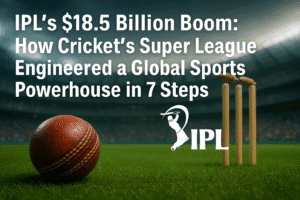IPL’s $18.5 Billion Boom: How Cricket’s Super League Engineered a Global Sports Powerhouse in 7 Steps
The Indian Premier League (IPL) has surged to an $18.5 billion enterprise value (up 13%) and $4 billion brand value (up 14%), cementing its status as a global sports powerhouse. Its financial dominance stems from a uniquely stable model: long-term media rights and sponsorships ensure “annuity-like” revenue, while an ₹120 crore salary cap controls costs and maintains competitive balance. Franchises lock in 80% of expenses pre-tournament, shielding profits.
The 2025 season saw record ad revenue ($600 million, +50%) and a groundbreaking 678 million viewers for the final — surpassing even India-Pakistan ICC clashes. New champions Royal Challengers Bengaluru topped team brand value ($269 million), proving on-field success translates commercially. Beyond cricket, the IPL’s fusion of entertainment, tech innovation, and commerce has reshaped global sports, inspiring leagues worldwide and establishing itself as a cultural cornerstone with a sustainable blueprint for growth.

IPL’s $18.5 Billion Boom: How Cricket’s Super League Engineered a Global Sports Powerhouse in 7 Steps
The Indian Premier League (IPL) isn’t just cricket; it’s a financial juggernaut rewriting the rules of global sports. Fresh analysis from investment bank Houlihan Lokey reveals the league’s enterprise value surged 13% year-on-year to a staggering $18.5 billion (approx. ₹1.6 lakh crore). Simultaneously, its brand value rocketed 14% to nearly $4 billion (₹33,000 crore). These aren’t just big numbers – they signal a fundamental shift in how sports leagues can operate and thrive.
The Business Model: Precision Engineering Meets Fan Frenzy
What truly sets the IPL apart isn’t just its valuation, but the near-frictionless efficiency of its revenue model, described by Houlihan Lokey as “a near-perfect blend of predictable cash flows and cost discipline.” Here’s the blueprint:
- Revenue Fort Knox: The bedrock is the BCCI’s long-term, expertly negotiated media rights deals and front-loaded sponsorships. This creates “annuity-like cash flows,” providing financial stability rare in global sports. Advertising revenue alone exploded by 50% in 2025, hitting $600 million (₹5,000 crore).
- Cost Containment Champion: Franchises secure almost 80% of their costs before the first ball is bowled. The linchpin? A strictly enforced salary cap (₹120 crore per team). This acts as an “embedded margin protector,” preventing the crippling wage inflation plaguing leagues like the EPL or NBA and ensuring genuine competitive parity. Teams must strategize, not just splurge.
- Superior Economics: The report explicitly states IPL’s cost-revenue structure now surpasses giants like the English Premier League (EPL) and the NBA in efficiency. For institutional investors, this positions the IPL as a “high-growth compounder” within entertainment, tapping into India’s massive, digitally-savvy audience with rising disposable incomes.
More Than Cricket: A Cultural & Commercial Catalyst
The IPL’s influence stretches far beyond the boundary rope:
- The RCB Effect: The 2025 season crowned a new champion – Royal Challengers Bengaluru (RCB), finally lifting the trophy after 18 years. This triumph translated directly into commercial dominance, propelling RCB to the top of the franchise brand value chart at $269 million, ahead of stalwarts Mumbai Indians ($242M), Chennai Super Kings ($235M), and Kolkata Knight Riders ($227M). Passion pays.
- Unmatched Engagement: The 2025 final between RCB and Punjab Kings shattered records with over 678 million views – exceeding even the coveted India-Pakistan clash in the ICC Championship earlier that year. This underscores the IPL’s unique pull.
- Global Blueprint: The IPL’s success has ignited a proliferation of short-format T20 leagues worldwide, “redefining the modern cricketing calendar” and embedding itself as a “cornerstone of contemporary popular culture.” It’s a template others scramble to replicate.
- Tech & Innovation Hub: The league relentlessly drives technological advancements (broadcast tech, fan apps, data analytics) and secures landmark sponsorships, constantly pushing the envelope on fan experience and commercial partnerships.
The Verdict: A League Built for Sustainable Dominance
The IPL’s 13% value surge isn’t accidental. It’s the result of a meticulously crafted ecosystem:
- Predictable Revenue: Secured by long-term rights and sponsorships.
- Controlled Costs: Enforced by the salary cap and pre-tournament cost locking.
- Fan Obsession: Delivering premium digital experiences to a massive, engaged audience.
- Cultural Resonance: Blending sport, entertainment, and national pride seamlessly.
Houlihan Lokey nails it: the IPL exists at the potent “intersection of sport, entertainment, and commerce.” It’s not merely a cricket tournament; it’s a global business phenomenon demonstrating how strategic financial discipline, coupled with fan-centric innovation and cultural resonance, creates unparalleled and sustainable value in the modern sports landscape. The $18.5 billion valuation is impressive, but the underlying engine ensuring its future growth is the real story. The IPL hasn’t just changed cricket; it’s redefined the playbook for sports leagues everywhere.
You must be logged in to post a comment.